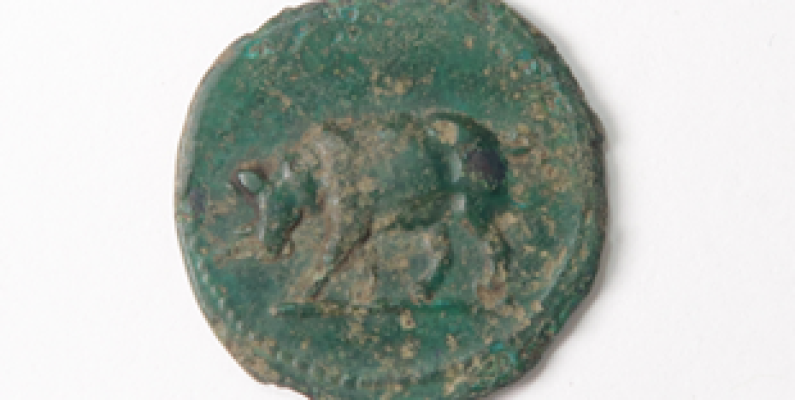
Sunday 22 September is World Rhino Day, a time to remember how much work still needs to be done to protect these magnificent creatures. Hunting, poaching, and loss of habitat have eroded their numbers in the wild almost to the point of obliteration. Of the five species, three are Critically Endangered (the Black, Javan, and Sumatran rhinos). The other two species, the White, and Indian rhinos, are surviving in greater numbers, but they are still under serious threat.
The attacks on the rhinoceroses’ environment and numbers are by no means new phenomena. We can easily take the capture and abuse of these animals back to the Roman Empire. Two coins in the Otago Museum are a poignant reminder of how the Romans viewed this animal.
The coins are examples of a denomination called a ‘quadrans’. This was the smallest unit of the Roman coin system in the first century CE: 1600 of these were equivalent to the highest value coin, the gold aureus. The quadrans measures about 18 mm in diameter, comparable to our current smallest coin, the 10 cent piece, which measures 20.5 mm. Each quadrans weighs less than three grams, while our 10 cent piece weighs 3.3 grams. The Roman coin was minted from copper, while the 10 cent piece is minted from copper-coated plated steel. Either way, both coins, ancient and modern, are the cheapest coins and very small change. These Roman coins were meant for the ordinary populace, not the wealthy.
On the obverse (heads) side of the coin, is a simple inscription in the centre – S C – which stands for ‘senatus consulto’, and signifies the mandate of the Roman state to mint coins ‘by decree of the Senate’. Surrounding this in a circle around the rim is another inscription – IMP DOMIT AVG GERM – which tells us that the coin was minted under the Emperor Domitian, whose name is followed by two of his titles, Augustus and Germanicus. The last title, Germanicus, helps us to date the coin to the years 83–85 CE, firstly, because Domitian took on this name late in the year 83, after returning to Rome in triumph from a war against the Chatti on the Rhine, in Germany. Secondly, from 85 CE, the small coinage of Rome added the office of Consul and the number of times Domitian had held it (eleven times by the year 85 CE, so the legend adds ‘COS XI’).

Image: Quadrans from the Roman Empire. E2017.586. Otago Museum Collection.
On the reverse (tails) side of the coin, is the extraordinary image that brings us back to the rhinoceros. A lone rhino is shown walking in profile to the left. Despite the tiny scale of the image, the animal has been carefully and unmistakably represented, right down to its twin horns, which show that it must be an African rhino.
The rhinoceros was a rare captive in Rome. One was included at the games marking the official opening of the Theatre of Pompey in 55 BCE, and the encyclopedia author, Pliny the Elder, writing around 70 CE, says that this specimen had a single horn on its nose (Natural History 8.29.71). This should mean that it was an Indian rhino on that occasion. The historian Suetonius, around 100 CE, tells us that the emperor Augustus showed off a rhino in the Saepta, the voting building in Rome (Life of Augustus 43.4). A later historian, Dio Cassius, writing around 200 CE, relates that Augustus held chariot races to celebrate the end of a famine – this was in 8 CE – and that “during these an elephant overcame a rhinoceros” (Roman History, 55.33.4). This is a reminder that the Roman interest in such unusual and rare creatures did not run to care and conservation, but instead they displayed the animals with the aim of pitting them against others, with one purpose in mind: their, or their opponent’s, violent and bloody end.
Nothing on Domitian’s coin explains the rhino’s presence, but we can tie it to games presented at the Flavian Amphitheatre, otherwise known as the Colosseum. The poet Martial goes into raptures in his poem, On the Spectacles, about these games, and twice mentions a rhinoceros at them (On the Spectacles 9 and 22). He says the animal had two horns, so we are dealing with the African type, either the White or Black, just as we have on the coin. With those two horns, Martial tells us, the rhino tossed a bear, but to get it to do so, and to delight the expectant audience, its handlers had to goad the rhino into an angry attack. The animal’s normally placid nature did not make for good entertainment, as Romans wanted it.
Martial’s poem has regularly been thought to be celebrating the opening games of the Colosseum, mounted by Domitian’s predecessor, his older brother Titus, in 80 CE. But the coins minted by Domitian suggest instead an event in his own time: this is Domitian’s rhinoceros on Domitian’s coin, minted a few years later. The Colosseum was not completed by Titus, but remained unfinished at his untimely death in 81 CE. It was Domitian who finished the building. The rhinoceros coins are the most common small coins surviving from his 15-year reign, and we may imagine them being thrown to the crowds at the Colosseum during games that Domitian put on for the public, as we know he did at other times.
The rhinoceros remained a rarity in Rome. The emperor that people nowadays most commonly associate with gladiatorial contests is Commodus, thanks to the movie Gladiator. Dio Cassius (Roman History, 72.10.3) tells us, “he often destroyed in public large numbers of men and wild animals as well: on his own he slaughtered with his own hands five hippopotamuses together with two elephants on successive days; and he also killed rhinoceroses and a giraffe”. Thank goodness Ridley Scott didn’t include that!
Top Image:Image: Quadrans from the Roman Empire. E2017.586. Otago Museum Collection.
